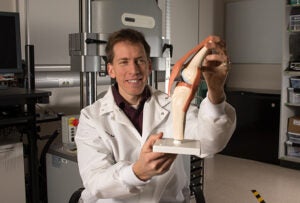Second Boise State 2016 CAREER Award Looks at Common Knee Injury

Second Boise State 2016 CAREER Award Looks at Common Knee Injury
BY: KATHLEEN TUCK PUBLISHED 7:06 AM / MARCH 1, 2016
Despite the fact that it’s one of the most prevalent injuries in the U.S., very little is known about the cause of meniscal tears in the knee. We know even less about how to restore full function once this painful injury does occur.
Trevor Lujan, assistant professor of mechanical and biomedical engineering, earned a five-year, $500,000 National Science Foundation CAREER Award to investigate why the meniscus fails so often and how the risk of failure is affected by age. The award is the NSF’s most prestigious program supporting junior faculty who effectively integrate outstanding research and education within the context of their organization’s mission.
The meniscus is the crescent-shaped cartilage disc in your knee that cushions the femur and tibia. It helps disperse the weight of the body and reduce friction during movement.
There are more than a half million incidents of acute meniscus tears in the U.S. each year and in about 90 percent of cases, there is no effective treatment for full recovery.
The meniscus has a limited capacity to heal due to a lack of blood flow. Therefore, the most common procedure to fix a meniscus tear is to surgically remove the damaged part of the tissue. However, partial removal of the meniscus will cause knee instability and increase the risk of osteoarthritis.
“We know that meniscus failures are pervasive and debilitating, but we don’t understand the structural and physical mechanisms that underlie this common injury,” Lujan said. “Injury can clearly be caused by large forces, but what is the impact of repeated loads?”
This study will investigate the failure mechanisms of meniscus tears, focusing on the effect of repeated loads, known as fatigue. Clinical studies have shown that tears are not all caused by sudden trauma and may be associated with repeated impacts.
Lujan wants to learn why some people are more susceptible to injury than others. “If we can understand the structural and mechanical origins of failure, we can identify gait patterns and physical activities that increase failure risk,” he said.
The study takes into account the fibrous network of the meniscus, and how age-related changes to this fibrous network will affect the susceptibility of meniscus tears. Lujan will divide the study into two groups: those under age 50 and those over age 50. Samples from cadavers will be loaded for up to 100,000 cycles as researchers attempt to characterize failure behavior.
Lujan hopes not only to understand if aging increases the risk of fatigue injuries, but also to use computational models to predict and visualize tears. These models will be developed in a collaborative effort with Daniel Schwen at Idaho National Laboratory. By describing and predicting injury, these models could lead to improvements in the treatment and prevention of meniscus tears.
The NSF CAREER grant also includes an educational component. Lujan will create 3D computer models that high school teachers can use to help students visualize why knee injuries happen in terms of physics and mechanics.
“The CAREER grant is unique in that it provides funding to integrate research into education,” Lujan said. “I’m delighted to have the opportunity to tie my biomechanics research into high school education and to support visual learning in engineering.”
This is the latest in a growing number of NSF CAREER awards to Boise State faculty, including one announced earlier this year to Paul Simonds in physics.